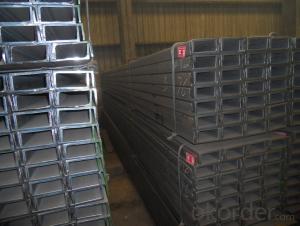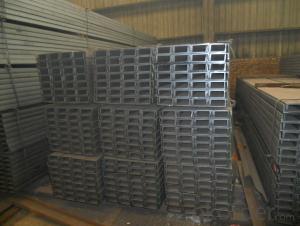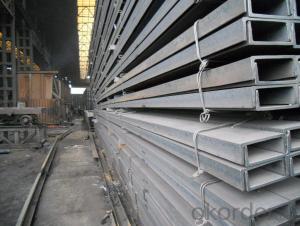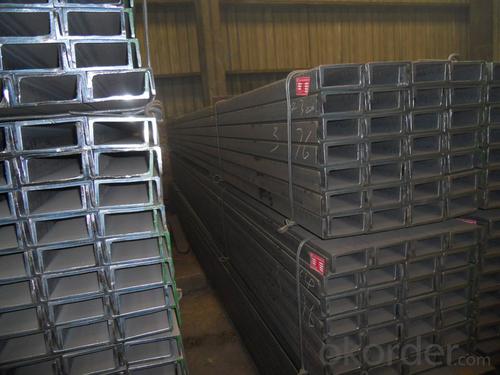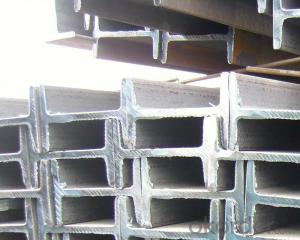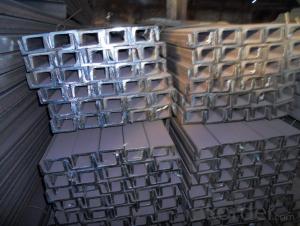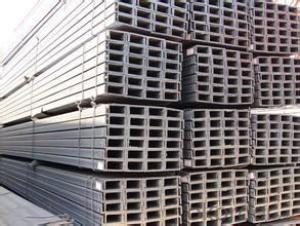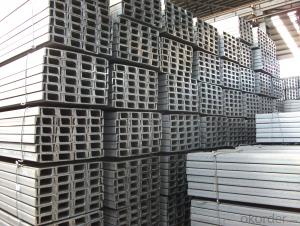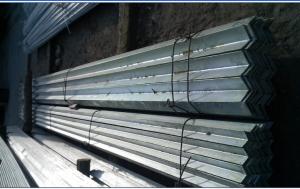Hot Rolled Carbon Steel U-Channel with Many Standard
- Loading Port:
- Tianjin
- Payment Terms:
- TT or LC
- Min Order Qty:
- 20 m.t.
- Supply Capability:
- 1000 m.t./month
OKorder Service Pledge
OKorder Financial Service
You Might Also Like
Product Description:
OKorder is offering Hot Rolled Steel U-Channel at great prices with worldwide shipping. Our supplier is a world-class manufacturer of steel, with our products utilized the world over. OKorder annually supplies products to European, North American and Asian markets. We provide quotations within 24 hours of receiving an inquiry and guarantee competitive prices.
Product Applications:
Hot Rolled Steel U-Channel can be applied to construction of warehouses, workshops, sport stadiums and car parks etc.The hot rolled channel steel belongs to carbon structural steel which is applied to in the field of construction and machinery.In details, the hot rolled channel steel is usually used for arch-itechtural structure, and they could be welded in order to support or hang a vari-ety of facilities. They are also usually used in combination with I beam. Generally,the hot rolled channel steel we supply must possess perfect welding property, riveting property and mechanical property and so on.
Product Advantages:
OKorder's Hot Rolled Steel U-Channel are durable, strong, and resist corrosion.
Main Product Features:
· Premium quality
· Prompt delivery & seaworthy packing (30 days after receiving deposit)
· Corrosion resistance
· Can be recycled and reused
· Mill test certification
· Professional Service
· Competitive pricing
Product Specifications:
We supply high quality MS Channel at reasonable price, including Chinese standard, Japanese standard and so on.
Standard | GB/JIS |
Material Grade | Q235,SS400 |
Technique: | Hot Rolled |
Sizes as per chinese standard: | 50*37*4.5mm - 300*89*11.5mm |
Sizes as per japanese standard: | 50*25*3mm – 200*80*7.5mm |
Length: | 6meter, 9meter, 12meter |
The chemical composition of HR Channel Steel according to Q235B
Alloy No | Grade | Element(%) | ||||
C | Mn | S | P | Si | ||
Q235 | B | 0.12-0.20 | 0.3-0.7 | ≦0.045 | ≦0.045 | ≦0.3 |
FAQ:
Q1: Why buy Materials & Equipment from OKorder.com?
A1: All products offered byOKorder.com are carefully selected from China's most reliable manufacturing enterprises. Through its ISO certifications, OKorder.com adheres to the highest standards and a commitment to supply chain safety and customer satisfaction.
Q2: How do we guarantee the quality of our products?
A2: We have established an advanced quality management system which conducts strict quality tests at every step, from raw materials to the final product. At the same time, we provide extensive follow-up service assurances as required.
Q3: How soon can we receive the product after purchase?
A3: Within three days of placing an order, we will begin production. The specific shipping date is dependent upon international and government factors, but is typically 7 to 10 workdays.
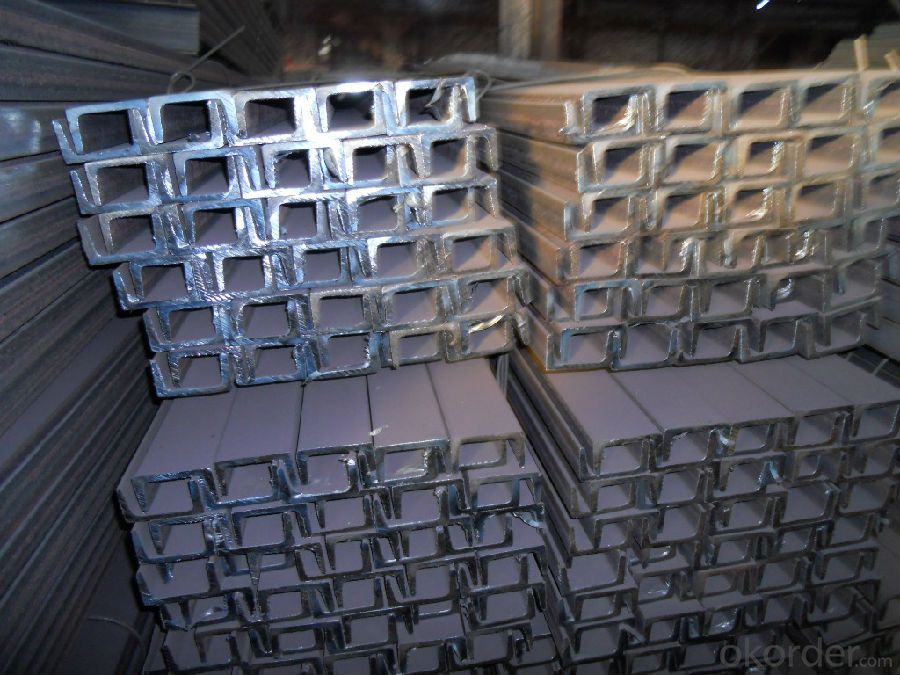
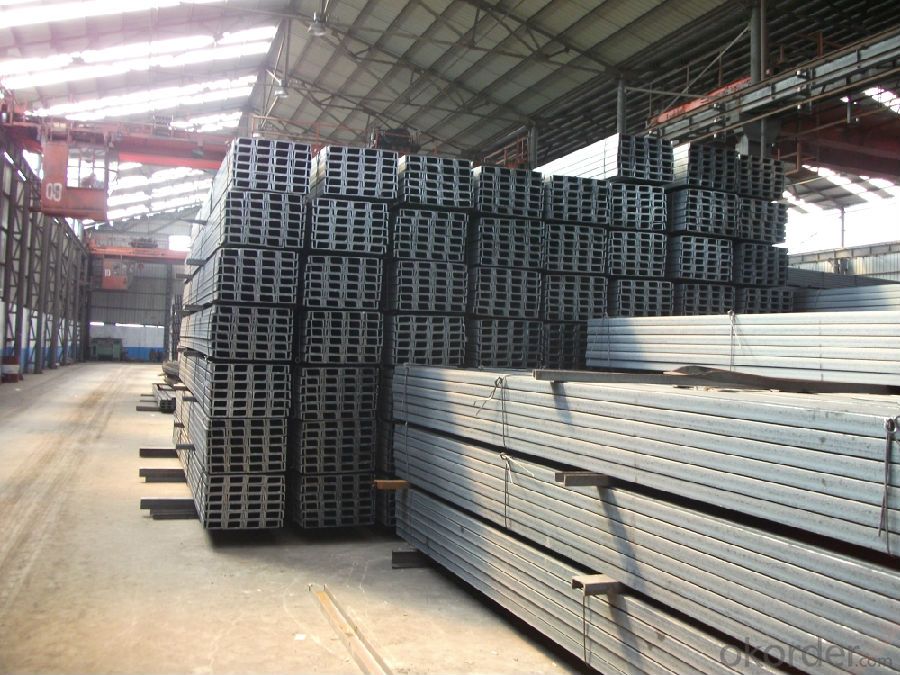
- Q: How do you calculate the moment of inertia for a steel I-beam?
- To determine the moment of inertia for a steel I-beam, one must take into account its geometry and dimensions. The moment of inertia, represented by I, measures the object's resistance to rotational motion changes. For an I-beam, which comprises a central web and two flanges, the moment of inertia can be computed using the parallel axis theorem. First, ascertain the I-beam's dimensions, including the height (h), flange width (b), web thickness (t), and flange length (L). These measurements are necessary for the calculations. The moment of inertia for the I-beam is the sum of two components: one for the web and another for the flanges. The formula for calculating the moment of inertia of a rectangular plate, like the web, is as follows: I_web = (1/12) * h * t^3 Where h represents the web's height and t represents the web's thickness. The moment of inertia for the flanges can be calculated using this formula: I_flanges = (1/12) * b * L^3 Where b denotes the flange width and L represents the flange length. Lastly, the parallel axis theorem can be applied to determine the total moment of inertia for the I-beam. According to this theorem, the moment of inertia about an axis parallel to an axis through the center of mass equals the sum of the moment of inertia about the center of mass and the product of the mass and the square of the distance between the two axes. Assuming the center of mass lies at the midpoint of the I-beam's height, the total moment of inertia (I_total) can be calculated as follows: I_total = I_web + 2 * I_flanges + 2 * (m_flanges) * (h/2)^2 Where m_flanges represents the mass of one flange, assuming both flanges have equal mass. By substituting the values for the dimensions and solving the equations, one can compute the moment of inertia for the steel I-beam. It is crucial to note that the actual dimensions and shape of the I-beam may vary, so using accurate measurements is essential for precise calculations.
- Q: What are the common types of connections used with steel I-beams?
- There are several common types of connections used with steel I-beams, depending on the specific application and structural requirements. Some of the most commonly used connections include: 1. Welded connections: Welding is a widely used method for connecting steel I-beams. It involves melting the edges of the two beams and fusing them together using heat. Welded connections provide excellent strength and rigidity, making them suitable for heavy-duty applications. 2. Bolted connections: Bolted connections involve using bolts and nuts to fasten the beams together. This method offers flexibility during installation and allows for disassembly if needed. Bolted connections are typically used in situations where frequent maintenance or modification is required. 3. Riveted connections: Riveting is an older method of connecting steel beams, but it is still used in certain applications. It involves using metal pins called rivets to connect the beams. Riveted connections are known for their strength and durability, but they can be time-consuming to install and require specialized equipment. 4. Pinned connections: Pinned connections allow for rotational movement between the beams. They typically involve using a pin or a bolt to connect the beams at a specific point, allowing for flexibility in the structure. Pinned connections are often used in structures that require some degree of movement or flexibility, such as bridges or seismic-resistant buildings. 5. Moment connections: Moment connections are designed to transfer both vertical and horizontal forces between beams. They are typically used in structures that require high load-bearing capacity and resistance to bending moments. Moment connections can be achieved through welding, bolting, or a combination of both. It's worth noting that the choice of connection type depends on various factors such as load requirements, structural design, cost, and construction feasibility. Consulting with a structural engineer or a design professional is essential to determine the most appropriate connection method for a specific steel I-beam application.
- Q: What are the different shapes of Steel I-Beams?
- Steel I-beams come in various shapes and sizes, each designed to serve different structural purposes. Some common shapes of steel I-beams include: 1. Wide flange beams (W-beams): These beams have a wider flange and a narrower web, resulting in a shape that resembles the letter 'W'. Wide flange beams provide excellent load-bearing capacity and are commonly used in construction and engineering projects. 2. American Standard beams (S-beams): These beams have a relatively narrow flange and a thicker web, resulting in a shape that resembles the letter 'S'. American Standard beams are often used in residential construction and are known for their versatility and cost-effectiveness. 3. Junior beams (J-beams): These beams have a shorter height and lighter weight compared to wide flange and American Standard beams. Junior beams are commonly used in light-duty applications, such as residential framing and small-scale construction projects. 4. H-piles: These beams have a wider flange and a thinner web, resulting in an 'H'-shaped cross-section. H-piles are primarily used in deep foundation applications, such as bridge and building piling, where the load-bearing capacity is crucial. 5. Channel beams: These beams have a U-shaped cross-section, with two horizontal flanges connected by a vertical web. Channel beams are often used in industrial applications, such as support frames and machinery bases. These are just a few examples of the different shapes of steel I-beams available in the market. The choice of shape depends on the specific requirements of the project, including the load-bearing capacity, span length, and structural design considerations.
- Q: Are steel I-beams recyclable?
- Yes, steel I-beams are highly recyclable. Steel is one of the most recycled materials in the world, and I-beams can be easily melted down and repurposed into new steel products. Recycling steel I-beams helps to conserve natural resources, reduce energy consumption, and minimize waste.
- Q: What are the transportation and handling considerations for steel I-beams?
- Transportation and handling considerations for steel I-beams include ensuring proper lifting and securing procedures, utilizing appropriate lifting equipment, such as cranes or forklifts, to prevent damage to the beams, and ensuring that the transportation vehicle is suitable for the size and weight of the beams. It is also important to protect the beams from exposure to moisture and corrosive elements during transit. Additionally, proper storage and handling techniques should be followed to prevent any bending or distortion of the beams.
- Q: How are steel I-beams measured?
- When measuring steel I-beams, their height, width, and weight per unit length are typically taken into account. The height, also referred to as the beam depth, is measured from the top to the bottom of the vertical part of the I-beam. The width, known as the flange width, is measured from one end of the horizontal section to the other. These measurements play a vital role in determining the overall size and load-bearing capacity of the I-beam. Apart from the height and width, the weight per unit length is also measured to determine the mass of the I-beam. This is crucial in calculating the structural strength and load-carrying capacity of the beam. To ensure uniformity in measurements and facilitate easy comparison and selection of I-beams for different construction purposes, industry standards such as ASTM or EN are typically followed. These standards guarantee consistency and enable straightforward evaluation and choice of I-beams. It should be noted that steel I-beams can come in various sizes and shapes, including wide flange beams, H-beams, and S-beams, among others. Each type of beam has its own unique measurements and specifications. Therefore, it is indispensable to refer to the manufacturer's specifications or engineering guidelines when accurately measuring and selecting the appropriate steel I-beam for a specific construction project.
- Q: How do steel I-beams perform in areas with high salinity or corrosive environments?
- Steel I-beams can perform well in areas with high salinity or corrosive environments, particularly if they are properly protected and maintained. High salinity and corrosive environments, such as coastal regions or industrial areas, can accelerate the corrosion process and potentially compromise the structural integrity of steel. To mitigate the effects of high salinity and corrosion, steel I-beams are often coated with protective materials such as galvanized coatings, epoxy coatings, or specialized paint systems. These coatings act as a barrier, preventing direct contact between the steel and the corrosive elements. Regular inspections and maintenance are also essential to identify and address any signs of corrosion early on. However, it is important to note that even with protective coatings, the lifespan of steel I-beams in high salinity or corrosive environments may be reduced compared to those in less corrosive environments. The severity of the environment, the quality of the coatings, and the maintenance practices all play a crucial role in determining the performance and longevity of steel I-beams in such conditions. In particularly harsh environments, alternative materials such as stainless steel or fiberglass-reinforced polymers (FRP) may be considered as they are inherently more resistant to corrosion. These materials offer extended durability and are often used in marine structures or other applications where corrosive conditions are prevalent. Overall, steel I-beams can still be a viable option in areas with high salinity or corrosive environments, provided that appropriate protective measures are taken and regular maintenance is carried out. Consulting with structural engineers or corrosion specialists can help determine the most suitable approach to ensure the long-term performance and safety of steel I-beams in such conditions.
- Q: Can steel I-beams be used for concert venues?
- Yes, steel I-beams can be used for concert venues. In fact, they are commonly used in the construction of large-scale structures such as stadiums, arenas, and concert halls. Steel I-beams provide excellent structural support and have a high load-bearing capacity, making them ideal for venues that need to accommodate a large number of people and heavy equipment. They can be used to create the framework for the roof, walls, and seating areas, ensuring a safe and sturdy structure for concerts. Additionally, steel I-beams can be easily customized and fabricated to meet specific design requirements, allowing architects and engineers to create unique and visually appealing concert venues.
- Q: How do steel I-beams perform in terms of impact resistance?
- Steel I-beams are known for their exceptional impact resistance. The unique design of the I-beam, with its flanges and web, provides a high level of strength and rigidity, making it highly effective in withstanding impact forces. When subjected to an impact, the I-beam distributes the force along its length, which helps to prevent deformation or failure. The structural properties of steel, such as its high tensile strength and toughness, further enhance its impact resistance. Steel is one of the strongest construction materials available, allowing I-beams to withstand heavy loads and absorb the energy of impacts without significant deformation or damage. Moreover, steel I-beams are often used in applications where impact resistance is crucial, such as in building structures, bridges, and industrial facilities. These beams can effectively resist dynamic loads, including sudden impacts, collisions, or even natural disasters like earthquakes or strong winds. It is worth noting that the specific impact resistance of steel I-beams can vary depending on factors such as the size and shape of the beam, the grade and quality of the steel used, and the design and construction techniques employed. Therefore, it is essential to choose the appropriate type of I-beam and ensure proper engineering and installation practices to maximize its impact resistance.
- Q: Can steel I-beams be used for convention centers or exhibition halls?
- Certainly, convention centers or exhibition halls can make use of steel I-beams. Steel I-beams are widely favored for extensive structures due to their robustness, longevity, and adaptability. They offer exceptional load-bearing capacities, enabling the creation of expansive and unobstructed areas, which are essential for convention centers and exhibition halls. Furthermore, steel I-beams can be effortlessly manufactured and installed, rendering them an economical choice for such colossal and intricate constructions. By incorporating steel I-beams in convention centers and exhibition halls, we guarantee the ability to sustain substantial loads, accommodate large gatherings, and provide the necessary flexibility for various event arrangements and setups.
Send your message to us
Hot Rolled Carbon Steel U-Channel with Many Standard
- Loading Port:
- Tianjin
- Payment Terms:
- TT or LC
- Min Order Qty:
- 20 m.t.
- Supply Capability:
- 1000 m.t./month
OKorder Service Pledge
OKorder Financial Service
Similar products
Hot products
Hot Searches
Related keywords
